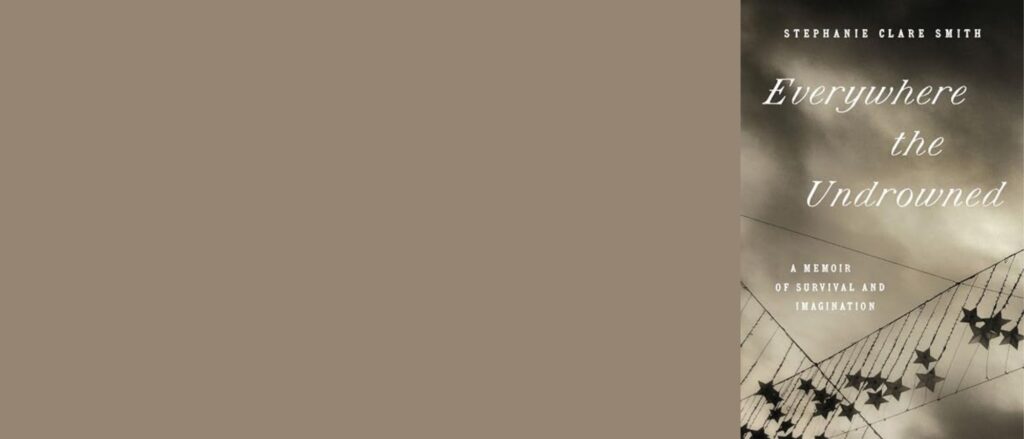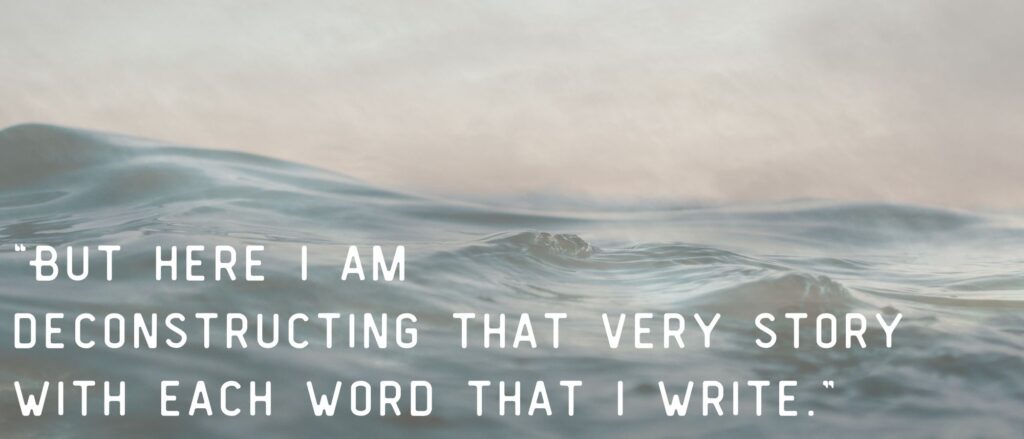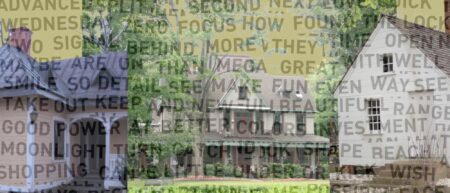In the summer of 1973, Stephanie Clare Smith is fourteen and all she can do is hang on. Her mother took off on a road trip out west and left Stephanie at home, alone in their New Orleans apartment. Everywhere the Undrowned (University of North Carolina Press) is Stephanie’s “sink or swim” memoir, a lyric debut that traces the events not only of that harrowing summer but also how the trauma that unfolded during those months echoes over the course of her life. As an adult, she works with families in crisis and meets a fourteen year old whose experience is “stunningly similar” to her own. She becomes the caregiver to the mother who both abandoned her and came back again and again. She learns it is an illusion that the past is behind us. She learns the importance of “bringing the past forward” where she can “tend to it better.” And, on the cusp of publication, Stephanie is still considering not only the ways her story has affected her, but how the sharing will as well.
Stephanie spoke with prolific memoirist Judy Goldman about writing and writing one’s past. The following is an edited and condensed version of their conversation.
Judy Goldman: I want to start by asking about the title of your book, Everywhere the Undrowned. How did you come to this title?
Stephanie Clare Smith: When I was growing up, my mother often said to me, “You sink or swim in this world.” This sets the stage for the summer where the memoir begins, when I am home alone at 14 years old. Swimming and watery themes continued to find their way to me as I wrote, and Undrowned became synonymous with surviving, with sinking and then swimming. The book expands to include the shared experiences of other survivors, how we are everywhere though we may feel invisible. I wrote, “Everywhere the undrowned learn to live small.” My wonderful agent at the time, Claire Anderson-Wheeler, suggested using the first part of that sentence as a title. I am so glad she did.

JG: We are drawn into your story immediately and see the lack of parental supervision and its consequences. In the latter part of your memoir, you ask yourself, “Is it my story that marks me or the telling that does it?” Naturally, surviving childhood sexual violence is going to leave its marks. Can you say more about the telling part of your question? How would telling your story mark you?
SCS: The subtitle of my book is A Memoir of Survival and Imagination because it was my imagination that allowed me as a child to create a feeling of connectedness out of thin air–a connection to my mother and to the world that I desperately needed since I was, in reality, very alone. But by telling my story, I am revealing and dismantling what I spent years constructing. It’s like what the writer Rebecca Solnit has said about our stories–that they are the compasses we navigate the world by. They are our inner architecture. But it’s not a static architecture, because nothing is static.
JG: Especially after a parent dies. The inner and outer landscape change in ways we can’t anticipate. What we see and have to say changes.
SCS: Yes, indeed.
It wasn’t until after my mother died, when I was in my 50s, that I could even allow myself to see the reality of how unprotected I was as a child. I couldn’t afford to threaten a certain version of my mother, a story I had forged in steel as a child to help me navigate my solitude. Fortunately, my mother had winning qualities that allowed my story to stick.
But here I am deconstructing that very story with each word that I write. I am the one who loses all the comfort that story once gave me. Like many who experienced childhood neglect, I struggle with feeling I am betraying my mother. Even now. Or perhaps especially now, because the dismantling is going public. I also say throughout the book that it’s a love story. A complicated love story in a complicated world.
In the book, I describe a family I worked with in my job as a mediator. The 14-year-old daughter had been removed from the home due to the lack of parental supervision. The court tasked me with facilitating a conversation with the family and the various agencies involved. The daughter naturally protected her mother in ways that were stunningly familiar to me. The mother’s situation and limits were heartbreaking. It was quite revelatory and painful for me to hover outside of that family while writing about my own.

JG: I can imagine. You know, revelatory is a good word for it. The most popular question I encounter whenever I have given a reading from one of my memoirs is, “Did you find it cathartic to write this book?” The question just drives me crazy. Journal writing is cathartic. Writing a memoir is art.
SCS: Someone who doesn’t know the extent of my story told me they hoped my book will help me let the past go. I wanted to ask, let it go where?
For the longest time, I felt I had let my story go, conquered it even. I kept it as far behind me as anyone could. But basically, all I’d done was silence it and not share it. What I didn’t see for ages was how my present life and architecture were completely infused by my past.
I listened to an interview with an historian who said the past is traveling along right beside us. We create the illusion that it’s behind us. I spent a lifetime leaning into the illusion. The historian’s point was to relate to the past since it’s right here in our midst.
JG: And this is the potential of all writing, but particularly memoir. Until I wrote my second memoir, I didn’t fully understand the role that reflection plays in the process. I tell my students all the time that memoir can’t be just a recounting of events. It must include reflection in some form.
SCS: And relating to the past doesn’t mean we are stuck there. A therapist encouraged me to bring my past forward. I didn’t know what she meant at first but came to understand that if I can bring the story I’d abandoned into the present, I can tend to it better. I can have compassion for it and listen to it. That’s the catharsis. I liken it to phantom limb syndrome. What we’ve amputated is cramping and twitching and causing pain until we work with it. That’s the real art, for all of us–mediating a productive conversation between our past and present. The writing, for me, is an offshoot of that artwork.
JG: There are so many layers we peel back in that work. It’s an excavation. I felt so relieved when I switched from writing fiction to memoir where the material is transparent. I’m excavating my own experiences. That’s our contract with the reader–to tell the truth as we experienced it.
SCS: Our present demands we relate to our past. Our hearts, our psyches insist on awareness sooner or later. I read an article about a 100-year-old World War II veteran who also left his past behind, amputated the pain, never talked about it, because that was considered the healthy thing to do. Then at 100 years old, he started having nightmares about the horror he’d lived through. His family arranged for him to talk with a therapist who helped him bring the past forward where he could relate to it with support. The nightmares went away as a result. I am impressed with his story on so many levels.
I understand how a painful past holds intense fear, like a sinkhole of pain that we think will suck us under forever and not let us live in the present. But our disowned past will send us nightmares of one kind or another to get our attention. Collectively, our fear about our national history operates the same way – the resistance, the call by some to move on as though it’s not right here traveling alongside us as the historian described. I am struck by the power each of us has in doing this work on our own regardless. A good example is your memoir Child where you relate to your personal past in the context of race relations in South Carolina at the time. That was a personal excavation.
JG: I always tell students that writing demands going into the hard places, the neglected places that feel risky. That’s where the real material is waiting.
SCS: Like compost.
JG: Yes. And that’s what the reader will want to read. Good writing of fiction or nonfiction is about letting yourself be uncomfortable and surprised. Going places that demand you take a risk. That discovery is one the reader is looking for.
SCS: Writing involves so many discoveries. For me, it opens intuitive pathways. I think that’s why I took to writing poetry as a kid. I felt like I was in the flow of something larger than my circumstances. Now intuition helps me trust the writing process. To know there is a flow that can’t be forced but can be entered and paid attention to.
JG: What helped you get to the place where you now feel ok with the telling part and its effects?
SCS: Good question. When I was fourteen, I read Jane Eyre over and over to feel less alone and to glean any words of wisdom from her perspective as a girl on her own. More recently, hearing the stories of survivors, their thoughts, and dilemmas, has been such a balm. There are some unique elements of my story that I didn’t think anyone else shared until I heard these women share their stories. If I can contribute to someone else feeling less alone, then that will be the best way for sharing my story to mark me.
Stephanie Clare Smith is the author of Everywhere the Undrowned: A Memoir of Survival and Imagination. She is an award-winning poet and essayist and a clinical social worker and mediator who works with at-risk families in the judicial system. She lives in Raleigh, North Carolina.
Judy Goldman is the author of three memoirs, two novels, and two collections of poetry. Judy’s latest memoir Child: A Memoir (University of South Carolina Press) was named a “Must-Read Book in 2022” by Katie Couric Media.



